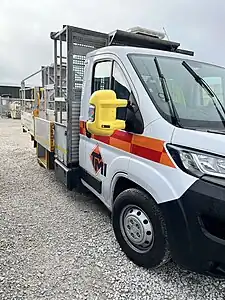
Specialised vehicle designed for traffic management installation
Traffic management is a key branch within logistics. It concerns the planning, control and purchasing of transport services needed to physically move vehicles (for example aircraft, road vehicles, rolling stock and watercraft) and freight.
Traffic management is implemented by people working with different job titles in different branches:
- Within freight and cargo logistics: traffic manager, assessment of hazardous and awkward materials, carrier choice and fees, demurrage, documentation, expediting, freight consolidation, insurance, reconsignment and tracking
- Within air traffic management: air traffic controller
- Within rail traffic management: rail traffic controller, train dispatcher or signalman
- Within road traffic management: traffic controller
Traffic Control Management is the design, auditing and implementation of traffic control plans at worksites and civil infrastructure projects. Traffic Management can include: flagging, lane closures, detours, full freeway closures, pedestrian access, traffic plans, and sidewalk closures.[1]
See also
- Air traffic control, a service provided by ground-based controllers who direct aircraft
- Road traffic control, directing vehicular and pedestrian traffic around a construction zone, accident or other road disruption
- Traffic control in shipping lanes
- Urban (peak-hour) traffic management
References
- ↑ Why Traffic Control is so important to the livelihood of your Community, City Rise Safety.
External links
 Media related to Traffic management at Wikimedia Commons
Media related to Traffic management at Wikimedia Commons
This article is issued from Wikipedia. The text is licensed under Creative Commons - Attribution - Sharealike. Additional terms may apply for the media files.